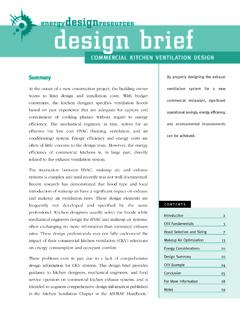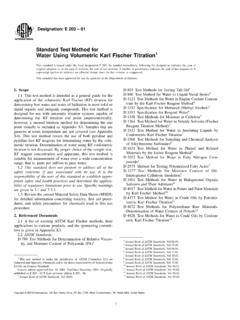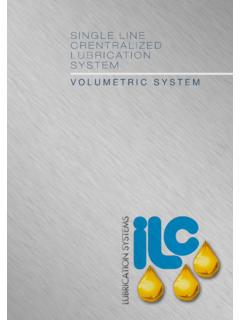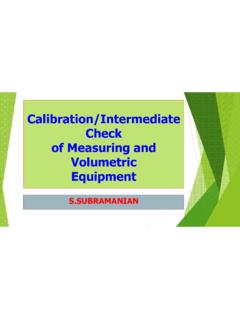Transcription of New Rules For Kitchen Exhaust - CulinAire Systems
1 26 ASHRAE Journal 2002 CBy William D. Gerstler, , Member ASHRAE ommercial Kitchen design professionals were concernedthat the minimum Exhaust air ductwork velocity of 1,500fpm ( m/s), as required by the National Fire ProtectionAssociation (NFPA 961), was too restrictive. ASHRAE Tech-nical Committee , Kitchen Ventilation, sponsored andprovided project guidance for a recently completed researchproject, RP-1033, addressing the relationship between grease deposi-tion and Exhaust velocity. The research project not only resulted inseveral published documents,2,3,4 but NFPA 96 reduced the minimumexhaust velocity to 500 fpm ( m/s) in March parameters, resulting in animproved understanding of the deposi-tion processes. From this information em-pirical models of the processes aredeveloped.
2 Actual cooking effluent mea-surements help validate the models for alimited real-world case (see sidebar onPage 30 for more information about thesetup and procedure).ResultsDeposition velocity is the fundamen-tal parameter used to describe the rate atwhich particles deposit to a surface. It isanalogous to a mass transfer coefficientand is calculated using Equation (1)This article summarizes the study thatinfluenced the change in NFPA 96 andpresents examples of how to benefit fromthe less restrictive requirements whileavoiding potential effluent consists of vaporsand particles. Previous experience5,6 in-dicates that using real cooking processesto produce cooking effluent for measure-ment purposes is expensive, uncontrol-lable, and leads to highly variableemission rates.
3 For this reason, the ex-perimental approach to address greasedeposition in Exhaust ductwork is tomeasure particulate and vapor deposi-tion rates separately using artificial cook-ing effluent. This allows control over theWhereVdep is the deposition velocity,N is the mass deposition flux, and C isthe particle mass concentration. For thisinvestigation, the mass concentrationwas calculated using the measured aero-sol concentration at the duct mass deposition flux is calculatedusingEquation (2)Wherem is the particle mass depositedon the surface, A is the surface area, and tis the accumulated collection time. Thedeposition velocity is of practical use incomparing particle deposition in real-world applications where the aerosol con-centration remains constant.
4 For example,when a high emission Kitchen applianceis replaced with a low emission appliance,and the total Exhaust volume is reduced,the aerosol concentration can remain con-stant. Likewise, when designing a newexhaust system, it is possible to adjust theThe following article was published in ASHRAE Journal, November 2002. Copyright 2002 American Society of Heating, Refrigerating and Air-Condition-ing Engineers, Inc. It is presented for educational purposes only. This articlemay not be copied and/or distributed electronically or in paper form withoutpermission of RulesFor KitchenExhaustAn ASHRAE research project led to a new NFPA Exhaust velocity 2002 ASHRAE Journal27duct size and corresponding volumetric flow rate while main-taining constant aerosol applications have a constant aerosol generation rate thatresults in an increase in particle concentration when reducing theexhaust velocity.
5 For instance, an appliance may be found tooperate effectively with reduced Exhaust volumetric flow ratewhile maintaining capture and containment. If the effluent emis-sions and Exhaust duct size remains the same, the result will notonly be a decrease in Exhaust velocity, but a corresponding in-crease in particle concentration. Therefore, the deposition veloc-ity is not the only parameter of interest; the rise in concentrationin the Exhaust also affects the particle deposition rate. Multiply-ing the deposition velocity by the concentration before and aftera change in Exhaust flow rate provides the mass flux to the wall ineach case, which allows for quantitative comparison. For discus-sion purposes, the situation with constant aerosol concentrationis referred to as Case I, and the situation with a constant aerosolgeneration rate is referred to as Case 1, the ordinate is the deposition velocity while theabscissa shows the collection area of the duct.
6 Measurementswere taken on all four sides of the horizontal Exhaust duct,thus the areas are designated top, bottom, and left and rightsides. The overall average deposition also is shown. Each chartshows results from all four tested Exhaust velocities. Isother-mal results for two particle sizes, and m are shownalong with non-isothermal results for the m particles at120 F and 150 F ( C and C) Exhaust data are directly applicable to Case isothermal cases, it is clear deposition velocity decreasesas the Exhaust velocity decreases. This is true for both thehorizontal surfaces (top and bottom) and vertical surfacesAbout the AuthorWilliam D. Gerstler, , is a mechanical engineer for General Electric sGlobal Research Center, Niskayuna, The research was performedwhile he was a graduate student at the University of Minnesota s MechanicalEngineering 1: Deposition velocity of polydispersed particles on the internal surfaces of a horizontal square Exhaust duct Exhaust velocity.
7 A) MMAD = m, isothermal conditions B) MMAD = m, isothermal conditions C) MMAD = m, Exhaust air temperature = 120 F ( C) D) MMAD = m, Exhaust air temperature = 150 F ( C).MMAD = m g = Velocity (fpm)BottomLeft SideRight SideTopTotalCollection AreaMMAD = m g = = 120 FDeposition Velocity (fpm)BottomLeft SideRight SideTopTotal500 fpm1,000 fpm1,500 fpm2,000 fpmCollection (fpm) T( F)500 ,000 ,500 ,000 = m g = = 150 FDeposition Velocity (fpm)BottomLeft SideRight SideTopTotal500 fpm1,000 fpm1,500 fpm2,000 fpmCollection (fpm) T( F)500 ,000 ,500 ,000 fpm1,000 fpm1,500 fpm2,000 fpmACBDMMAD = m g = Velocity (fpm)BottomLeft SideRight SideTopTotalCollection Area500 fpm1,000 fpm1,500 fpm2,000 fpm28 ASHRAE Journal 2002(left and right sides).
8 The deposition is higher at the bottomsurface and lower at the top surface due to the effects of gravi-tational settling. The sides are unaffected by gravitationalsettling. The other deposition mechanism at work is calledturbulent aerosol deposition. Higher turbulence results inmore particles thrown to the wall surface. Lowering theexhaust velocity does not affect gravitational settling, butdoes decrease turbulent deposition dramatically. The net re-sult is a decrease in deposition. While not shown in the fig-ure, similar results were found for the two smaller particlesizes, and the result to Case II is more complicated. Forvertical surfaces, the deposition velocity decreases much morerapidly than the particle concentration increases, thus thereis still a significant decrease in deposition with decreasingexhaust velocity for all particle sizes tested.
9 For the bottomsurface, higher gravitational settling due to higher particleconcentrations either cancels out the decrease in depositionvelocity (largest particles), or begins to dominate (smallerparticles). The net result for all internal surfaces of a horizon-tal duct is a reduction in deposition with decreasing exhaustvelocity for the m particles, a constant deposition forthe and m particles, and a minimal value of depo-sition at about 1,000 fpm ( m/s) with a slight increase asthe velocity goes to 500 fpm ( m/s) for the m par-ticles. The magnitude of the mass deposition is much greaterfor the larger particles. When a wide size range of particles ispresent, the behavior of the largest ones will dominate theoverall deposition. This suggests that in most cases, reducingthe Exhaust volume will either decrease aerosol depositionor not change it the Exhaust air temperature is elevated and there isan appreciable wall- Exhaust air temperature difference, thephenomena of thermophoresis becomes an important deposi-tion mechanism.
10 Thermophoresis causes particles to migratefrom hot to cold air temperatures due to uneven thermallyinduced collisions with gas molecules. The momentum fromthe hot side air molecules is greater than the momentum fromthe cold side air molecules and the particle moves towards thecold. The charts for the elevated Exhaust air temperature (Cand D) show that eventually thermophoresis begins to domi-nate particle deposition for Case I applications. However, evenat the highest temperature difference tested, the depositionvelocity does not increase for horizontal surfaces, but remainsrather constant. When applied to Case II applications, deposi-tion begins to increase with decreasing Exhaust velocity, atthe wall- Exhaust air temperature differences tested.








